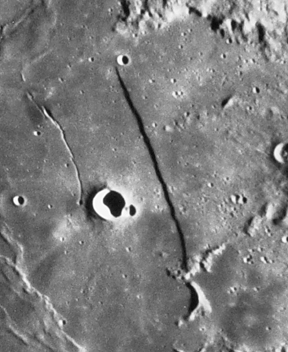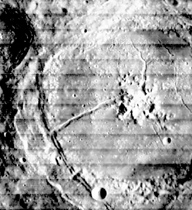Geologic Processes on the Moon/Tectonic Processes
|
Tectonism refers to those forces that form and deform the lunar surface. Examples of these forces include the formation of mare ridges and arcuate rilles, along with relatively weak moonquakes. The forces causing deformation can be endogenous (forces generated within the moon’s interior) or external (forces generated by external objects such as a meteorite impact). Below we will examine the nature and history of these various forces, along with the lunar features caused by each.
Impact Induced Processes (external)
Meteorite impacts create a shock wave that propagates through the lunar surface. If the shock wave contains sufficient energy, it can have a variety of effects distant from the actual impact site. Examples of this include faulting of the subsurface bedrock and destabilization of surface materials. Let us examine each of these in turn.
When a massive, basin forming impact occurs, it creates faults in the subsurface layers of the moon. Such faulting is generally concentric to the impact (around the basin’s sides). Arcuate rilles were formed in this way (Fig. 1). It is likely that these faults were initially unexposed, and thus not visible. At a later time, lavas poured into the basins, creating downward and inward stresses. These stresses pulled at the faults (extensional forces), causing them to activate (opening along the fractures). However, something peculiar sometimes happened at the outer edge of these basins: the extension pulled the inner fracture wall slightly more inward than it did the outer fracture wall. This caused the overlying surface to fall straight down between the walls (Fig. 2), producing a graben (a flat valley with steep side walls). The side walls were the inner and outer edges of the fractures and the valley is where the overlying layers dropped. Examples of arcuate rilles and grabens are easily seen, even in small telescopes, around the lunar basins. A particularly stunning set occurs on Mare Humorum.
When a massive, basin forming impact occurs, it may also create faults radial to the basin, and these may be at some distance to the basin itself. These were generally covered by the ejecta of the basin impact (the megaregolith). Because the shock wave that created the fault moved much more quickly than the eject, the ejecta arrived later, covering the area with a layer of dust and rock. While initially covered by ejecta, the radial faults were later activated by other stresses. One such stress was the emplacement of lava, creating differential stresses across a fault. An example of this is the Straight Wall, where lava created sufficient stress to activate the fault (Fig 3). Other examples of activated radial faults include the Cauchy Rilles and the rilles in Lacus Mortis (Fig 4).
Additionally, semi-stable material can be made unstable by an impact’s shock wave. The most common place to find semistable materials is on the rim of a crater’s wall, where the end products of ejection were ‘lobbed’ onto the rim. When a shock waves passes through such materials, they may slide down the steep side wall, in a small landslide (Fig 5). The vast majority of these events are too small to be resolved by earth-based telescopes.
Volcanism as a Tectonic Process (endogenous)
Other types of tectonic activity are found in association with volcanism. Lava, because it comes from the mantle, is denser than the overlying crust. This denser rock, once it pools on the surface, creates local stress fields in the underlying bedrock, activating preexisting faults and creating arcuate rills. These stresses also produce mare ridges and floor fractured craters. We will address each of these in turn.
Mare ridges form in a variety of situations, though all are related to the stresses induced by lava flows. One type forms over submerged basin rims. This type begins when magma fills the inner reaches of the basin, eventually covering an inner basin rim. At this point we have a shallow shelf of lava over the rim and a much deeper shelf where the rim falls off (on the sides). The lava will subside more over the deep area and less over the shallow area, inducing a local stress field in the cooling, plastic lava. In such an area, a mare ridge will form along the basin’s covered rim. Indeed, it is only by examining such mare ridges that we can tell where submerged basin rings exist! Excellent examples of mare ridges are visible, in small telescopes, over Mare Imbrium (Fig 6), Mare Serenitatis (Fig 7), and the smaller Sinus Aestuum.
A second type of mare ridge forms when a volcanic intrusion occurs under a shelf of cooling, plastic lava. Here the magma rises in a linear fault, which acts as a zone of weakness in the rock (such intrusions are called ‘dikes’). This creates a linear mare ridge, and in such examples, small magma extrusions are occasionally seen (where the magma finds access to the surface). A third type of mare ridge forms when a blind thrust fault (a fault that fails to break the surface) creates local stresses in the overlying lava. If this occurs while the magma is still cooling, and thus relatively plastic, it will form a mare ridge. These latter two types of mare ridges are impossible to distinguish from each other in earth-based telescopes, though one would expect a sharper profile on one side in the latter case. Figures 8 and 9 show spacecraft images of such mare ridges, and Figure 10 is a high resolution image of a mare ridge section.
Floor fractured craters are craters that have a series of rilles in their floors created by volcanic processes (these must be distinguished from sinuous rilles, which also occur in craters). When large meteorites strike the moon, they produce faults deep beneath that crater’s floor. If rising magma accesses these faults, it will preferentially track up these ‘zones of weakness’ in its movement towards the surface. Once under the floor of the crater, the magma collects in a pocket. With sufficient pressure, the magma will cause the crater’s floor to bow upwards, and even to fracture into a series of plates. Thus, floor fracture craters are the end result of lava creating pressure underneath the floor of a crater. Since magma is preferentially found in the lunar basins, most floor fracture craters are found adjacent to the great basins. Examples of floor fractured craters include Crater Gassendi (fig 11) and Crater Petavius (fig 12).
Tidal Interactions (external)
Tidal forces refer to the stresses induced by gravity between planetary bodies. For example, the ocean tides on earth are caused by tidal stresses induced by the moon. As earth is larger, it induces proportionally larger stresses on the moon. Before the moon was in locked rotation with respect to earth (the same side of the moon always faces the earth), this distortion produced moonquakes and subsurface faulting. However, tidal friction also caused tidal slowing—the friction of these events slowed the moon’s spin. Eventually, the moon locked into synchronous rotation. Interestingly, the moon is also causing tidal slowing of the earth, and our spin is ever so minutely slowing across time.
Now, since the moon is locked in rotation with earth, one might expect little seismic activity on the moon. However, the seismic monitors left by the Apollo missions revealed small moonquakes--Richter Scale 2-3. This is because the moon still has some wobble (librations), which causes changing tidal stresses, resulting in these continuing moonquakes. The faults induced by such stresses are not visible from earth. Most are deep under the moon’s surface.
Cooling (endogenous)
The only currently active endogenous tectonic force is that induced by the moon’s continued secular cooling. With cooling comes shrinkage of the more plastic mantle. However, the rigid crust cannot shrink with it. This creates local stress fields which are eventually released by thrust faulting (the crust on one side of the fault slides up diagonally over the other side). Similar faults exist on Mercury where the shrinkage has been even greater. While these faults are small, there are many of them, and they are continuing to form. Faults from this cause are likely not visible from earth-based telescopes. Figure 13 is an Apollo image of a fault possibly created in this manner.
Articles in this Series
- Geologic Processes on the Moon - Parent Article
- Cratering on the Moon - First Article
- Tectonic Processes - Second Article (You Are Here)
- Volcanism - Third Article




















